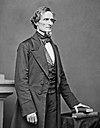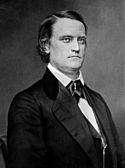John Cabell Breckinridge
 Wiceprezydent John Breckinridge pomiędzy 1865 a 1880 rokiem | |
| Data i miejsce urodzenia | 16 stycznia 1821 Lexington |
|---|---|
| Data i miejsce śmierci | 17 maja 1875 Lexington |
| 14. wiceprezydent Stanów Zjednoczonych | |
| Okres | od 4 marca 1857 do 4 marca 1861 |
| Przynależność polityczna | Partia Demokratyczna |
| Druga dama | Mary Cyrene Burch Breckinridge |
| Poprzednik | William R. King |
| Następca | Hannibal Hamlin |
 | |
| generał major | |
| Data i miejsce urodzenia | 16 stycznia 1821 Lexington |
|---|---|
| Data i miejsce śmierci | 17 maja 1875 Lexington |
| Przebieg służby | |
| Lata służby | 1861–1865 |
| Siły zbrojne | Armia Stanów Skonfederowanych |
| Główne wojny i bitwy | wojna secesyjna |
| Późniejsza praca | Sekretarz wojny Skonfederowanych Stanów Ameryki |
John Cabell Breckinridge (ur. 16 stycznia 1821 w Lexington, zm. 17 maja 1875 tamże) – amerykański polityk związany z Partią Demokratyczną.
W swojej karierze politycznej między innymi reprezentował stan Kentucky w Izbie Reprezentantów Stanów Zjednoczonych i Senacie Stanów Zjednoczonych, a także był 14. wiceprezydentem Stanów Zjednoczonych.
Wybory prezydenckie
Kandydował w wyborach prezydenckich 1860 r. Przegrał z Lincolnem. Wybory pokazały wielkie różnice w poglądach między północnymi, a południowymi stanami: Niemal wszystkie głosy elektorów jakie otrzymał pochodziły ze stanów południowych. Które niezadowolone wynikiem tych wyborów ogłosiły później secesję i utworzyły Skonfederowane Stany Ameryki. Na CSA składało się jedenaście stanów, a pośród nich nie wygrał tylko w Tennessee. A spośród stanów unijnych wygrał tylko w niewolniczych Delaware i Maryland.
Podczas wojny secesyjnej generał armii Konfederacji i ostatni sekretarz wojny Skonfederowanych Stanów Ameryki.
Bibliografia
- Biografia w Biographical Directory of the United States Congress (ang.)
- John Cabell Breckinridge, 14th Vice President Senat Stanów Zjednoczonych
Media użyte na tej stronie
Seal of the Vice President of the United States. The blazon is defined in Executive Order 11884 as:
The design is the same as the Seal of the President of the United States, except that there is no ring of stars, the clouds are gray (instead of proper), the stars are gray (instead of argent), the scroll is gray (instead of white), the arrows are gray (instead of proper), and the background colors and inscription (obviously) differ.The Coat of Arms of the Vice President of the United States shall be of the following design:
SHIELD: Paleways of thirteen pieces argent and gules, a chief azure; upon the breast of an American eagle displayed holding in his dexter talon an olive branch proper and in his sinister a bundle of thirteen arrows gray, and in his beak a gray scroll inscribed "E PLURIBUS UNUM" sable.
CREST: Behind and above the eagle a radiating glory or, on which appears an arc of thirteen cloud puffs gray, and a constellation of thirteen mullets gray.
The Seal of the Vice President of the United States shall consist of the Coat of Arms encircled by the words "Vice President of the United States."
Logo of the Democratic Party of the United States. Dark blue D inside a dark blue circle.
James Buchanan (cropped from the original image)
Logo of the United States White House, especially in conjunction with offices like the Chief of Staff and Press Secretary.
John C. Breckinridge. Library of Congress description: "Breckinridge, Hon. John C. Senator from Ky. General in CSA, Sec of War Confederate Cabinet"
| To zdjęcie było poddane obróbce cyfrowej i może różnić się od wersji oryginalnej. Zmiany: Scratches removed, cropped, brightness/contrast. Oryginał można obejrzeć tu: John C. Breckinridge - Brady-Handy.jpg:
|
Jefferson Davis
Signature of John C. Breckinridge
Confederate Major General John C. Breckinridge
Signature of John C. Breckinridge.















